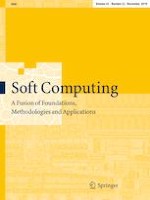08.01.2019 | Methodologies and Application
Using virtual samples to improve learning performance for small datasets with multimodal distributions
Erschienen in: Soft Computing | Ausgabe 22/2019
EinloggenAktivieren Sie unsere intelligente Suche, um passende Fachinhalte oder Patente zu finden.
Wählen Sie Textabschnitte aus um mit Künstlicher Intelligenz passenden Patente zu finden. powered by
Markieren Sie Textabschnitte, um KI-gestützt weitere passende Inhalte zu finden. powered by
